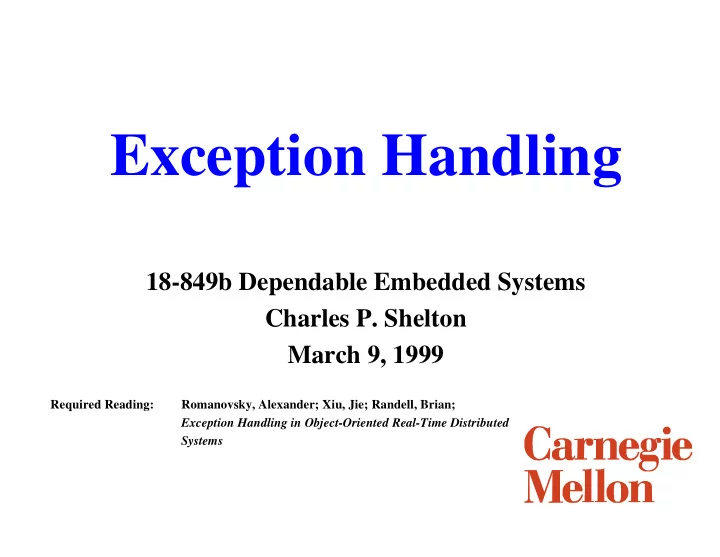

Exception Handling 18-849b Dependable Embedded Systems Charles P. Shelton March 9, 1999 Required Reading: Romanovsky, Alexander; Xiu, Jie; Randell, Brian; Exception Handling in Object-Oriented Real-Time Distributed Systems
Overview: Exception Handling ◆ Introduction ◆ Key concepts • Known versus Unknown exceptions • Forward and Backward error recovery • Robust Exception Handling versus Real-Time System Constraints ◆ Tools / techniques • Dependability Cases • Xept ◆ Metrics • Ballista ◆ Relationship to other topics ◆ Conclusions & future work 2
YOU ARE HERE ◆ Exception Handling is a method of achieving Robustness: Fault Injection ROBUSTNESS Exception VERIFICATION/ Handling VALIDATION/ CERTIFICATION 3
Introduction: Exception Handling ◆ Exception Handling is the method of building a system to detect and recover from exceptional conditions • Instances of things occurring outside the specifications of normal operation • Incorrect input • Memory/Data corruption • Software defects • Environmental anomalies, etc. ◆ Exception failures are estimated to account for up to 2/3 of system crashes and 50% of security vulnerabilities 4
Known versus Unknown Exceptions ◆ Known exceptions • Exception handlers can be written for exceptional conditions the designers know are likely to occur • Code reviews, walkthroughs, and testing can illuminate more conditions that can be accounted for • e.g. checking for null pointers, validating inputs to modules, assuring files exist before attempting to read/write to them, etc. ◆ Unknown exceptions • Designers cannot achieve complete coverage of all exceptional conditions • What about complex situations no one could anticipate? • Build in graceful degradation to exception handlers to minimize damage 5
Forward and Backward Error Recovery ◆ Forward Error Recovery: Programmed Exception Handling • When an exceptional condition is reached, call exception handler to recover from error condition, but try to continue execution from error state back to normal operation • Implemented for known exceptional conditions at design stage ◆ Backward Error Recovery: Default Exception Handling • Catch-all for unanticipated exceptions and design defects • Exception handler halts execution and tries to return system to a previous known state • Good for protecting against transient and intermittent errors, where simply retrying the operation will fix the problem 6
Exception Handling vs. Real-Time Systems ◆ Robust Exception Handling may require extra processing time • Transferring control from module to exception handling routine • Resetting system state and retrying an operation ◆ Real-Time Systems may not tolerate delays due to exception handling • Exception Handling routines may not be factorable into deadline constraints because of unpredictability of whether exceptions will occur • More bulletproof exception handling may require longer code and longer processing time to account for different execution paths 7
Tools / Techniques ◆ No rigorous methods of exception handling design exist ◆ Major problem is covering all exceptional cases • traditional software engineering techniques; code walkthroughs, code reviews, testing • Dependability cases develop taxonomies for improving coverage ◆ Xept • Method of automatically generating software wrappers correcting for exceptional inputs before passing them to the software module • Useful for COTS software where source code is not available for modification but you want more exception handling than module provides 8
Metrics ◆ Measuring a system’s level of exception handling is difficult • How can we know a system handles all exceptional conditions if we cannot think of all possible exceptions? • Exhaustive testing is intractable ◆ Ballista • Black box method of testing software modules’ responses to exceptional inputs • Measured relative robustness of POSIX operating systems • Limited to repeatable exceptions at the module level; exceptions occurring from complex interactions not covered • Exceptional inputs must be generated by developers 9
Relationship To Other Topic Areas ◆ Robustness ◆ Fault Tolerant Computing ◆ Software Fault Tolerance ◆ Checkpoint/Recovery • Method of handling exceptions by returning system to a known state ◆ Security • Robust exception handling will patch a lot of security holes ◆ Human Interface/Human Error • Humans are one of the biggest sources of exceptional inputs to a system • Exception Handling at the HCI level may prevent propagating faults 10
Conclusions & Future Work ◆ Conclusions • Coverage is a major problem. It is unrealistic to cover all exceptional conditions because they are not predictable • It is difficult to develop strategies to safely handle exceptions for unanticipated situations • Tradeoff between developing robust exception handlers and meeting real-time system deadline constraints ◆ Future Work • Xept and Ballista: Generating software wrappers for trapping exceptional inputs to COTS software modules • Using object-oriented techniques to structure designing exception handlers 11
Paper: Exception Handling in RT Systems ◆ Trying to apply Object-Oriented techniques to exception handling in real-time distributed systems ◆ Uses coordinated atomic (CA) actions to encapsulate all operations and exception handling procedures • CA actions coordinate and operate on system objects • CA actions manage real-time deadlines and confine scope of exception handlers ◆ Developing a more structured approach to resolving exception handling and real-time constraints • Addresses both timing constraints and exceptions as well as data and procedure exceptions 12
Recommend
More recommend